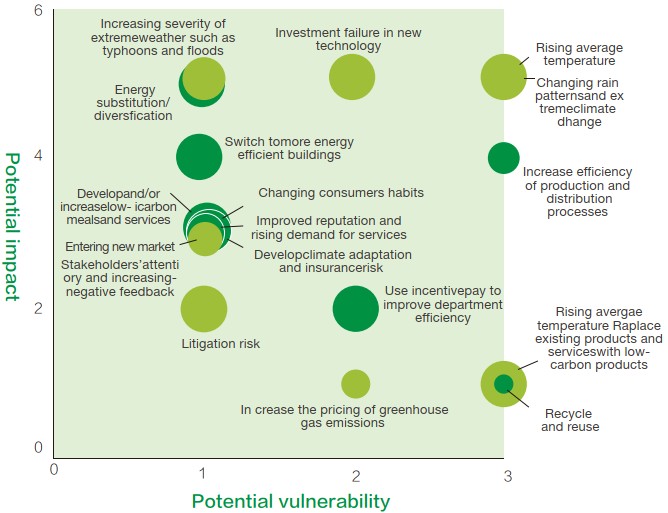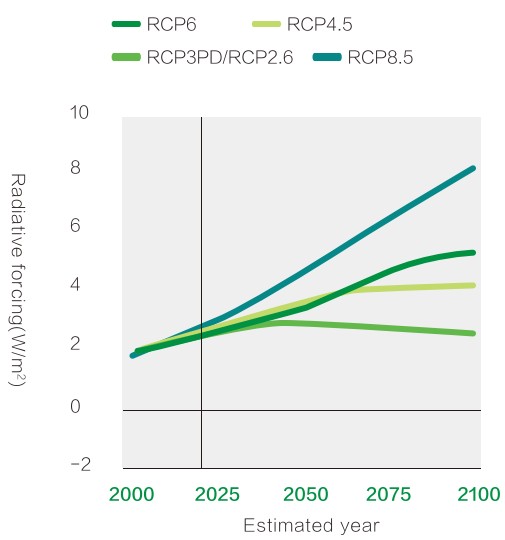Climate Change 





Climate Change Adaptation
The Financial Stability Board established the Task Force on Climate-related Financial Disclosures (TCFD) in 2015 to develop recommendations for more effective climate-related disclosures, which enable stakeholders to better understand the financial system's exposures to climate-related risks. An-Shin follows the recommendations of the climate-related financial disclosure report published by TCFD, which includes governance, strategy, risk management, and metrics and targets.
The actual and potential impacts of climate-related risks and opportunities on the organization's businesses, strategy, and financial planning.
Metrics and Targets
The metrics and targets used to assess and manage relevant climate-related risks and opportunities.
Core Elements of Recommended Climate-Related Financial Disclosures
Governance
The organization's governance around climate-related risks and opportunities.
Risk Management
The processes used by the organization to identify, assess , and manage climate-related risks.
Climate Change Governance
According to the Global Risk Report 2020 published by the World Economy Forum (WEF), the top 5 most concerned risks over the course of the next 10 years are environmental-related. This was also the first time in the 15-year history of the Global Risks Report, which climate-related risks, including extreme climate, climate action failure, threats to biodiversity, and etc. becoming the focus topics instead of economic issues. Despite the COVID-19 crisis, the climate change issues are gaining more and more attention. An-Shin established CSR Committee in 2014 which is responsible for the CSR related affairs within the company. The committee currently consists of five directors, including 1 independent director, and the independent director serves as the convener and chairman of the meeting which was held at least 2 times per year.
Climate Change Risk Management
In response to the potential risks of climate change and energy supply, An-Shin implements energy-saving and water-saving related projects from economic, environmental and social aspects. We contributes to sustainability by developing vegetarian products and offering low carbon services. An-Shin follows the recommendations of the climate-related financial disclosure report published by TCFD since 2019, and starts to collect, identify, and evaluate the financial impacts of climate change to reduce risks and discover opportunities.
Climate Change Strategy
At the Paris Conference in 2015, nearly 200 countries adopted the goal to hold global average temperature increase to "well below 2° C above pre-industrial levels and pursuing efforts to limit the temperature increase to 1.5°C above pre-industrial levels". The Inter-governmental Panel on Climate Change (IPCC) published a special report in 2018 on the impacts of global warming of 1.5 ° C above pre-industrial levels and related global green-house gas emission pathways, and emphasized how a 0.5 ° C rise will affect the lives of millions of people. The European Commission announced the European Green Deal in 2019 and boosted the engagement of countries to achieve net-zero emissions in 2020.An-Shin follows the IPCC Assessment Report 5 (AR5), defines the future warming scenario by Representative Concentration Pathways (RCPs) and selects the RCP2.6 and RCP8.5 warming scenarios. 
Dilemma between Entity Level Risks and Transformatoin Risk:
| Type | Scenario | Description | End of 21st century | Emission control | ||||||||||
|---|---|---|---|---|---|---|---|---|---|---|---|---|---|---|
|
Global warming leads to entity level risks
▲| ▼ Low carbon economy leads to transformation risks
|
RCP8.5
(High-emissions scenario)
|
|
4℃
(Warming reaches 4°C
above pre-industrial
levels)
|
High emissions
|
||||||||||
|
RCP2.6
(Mitigation scenarios)
|
|
1.5℃
(Limit the temperature
increase to 1.5℃ above
pre-industrial levels)
|
Low emissions | |||||||||||
| Type | Type | Type | Description | Type of Impact | Potential Financial Impacts for An-Shin | ||||||||||||||
|---|---|---|---|---|---|---|---|---|---|---|---|---|---|---|---|---|---|---|---|
| Risk | Transformation | Policies and regulations |
|
Increase in Operating Expenses |
|
||||||||||||||
|
Increase in Operating Expenses |
|
|||||||||||||||||
| Technical |
|
Decrease in Demand |
|
||||||||||||||||
|
Early Scrapping of Assets |
|
|||||||||||||||||
| Reputation |
|
Decline in Oper-
ating Profit
|
|
||||||||||||||||
| Immediate |
|
Decline in Operating Profit |
|
||||||||||||||||
| Long-term |
|
Early Scrapping
of Assets
|
|
||||||||||||||||
|
Increase in Oper-
ating Expenses
|
|
|||||||||||||||||
|
Type |
Type |
Type |
Description |
Types of Impact |
Potential Financial Impacts for An-shin |
|||||||||||||
|---|---|---|---|---|---|---|---|---|---|---|---|---|---|---|---|---|---|---|
|
Opportunity |
Opportunity |
Product and Service |
|
Increase in Market Demand |
|
|||||||||||||
|
Resource Efficiency |
|
Increase in Production Capacity |
|
|||||||||||||||
|
Increase in Operating Expenses |
|
||||||||||||||||
|
Increase in Asset Value |
|
||||||||||||||||
|
Energy Source |
|
Increase in Market Demand |
|
|||||||||||||||
|
Product and Service |
|
Increase in Market Demand |
|
|||||||||||||||
|
Market |
|
Develop New Markets |
|
|||||||||||||||
|
Increase in Capital |
|
||||||||||||||||
|
Flexibility |
|
Stable supply chain |
Sign contracts with farmers or use imported products for some of the agricultural products to maintain the stability of supply chain, control operating costs, and minimize the procurement risks. |
|||||||||||||||
Targets and Indicators of Climatic Change
Aside from improving energy efficiency and investing in An-Shin Smart Farm, An-Shin plans for the scope 1 and 3 of carbon emissions to effectively manage the impacts of climate change and opportunities. We hope to increase our flexibility to face climate change chal-lenges and able to drive the industry innovation.
|
SDGs |
Performance Indicators |
2020 Goals |
2020 Action Plans |
2020 Results |
Mid- to Long Term Goals |
||||||||||
|---|---|---|---|---|---|---|---|---|---|---|---|---|---|---|---|
|
|
Energy Efficiency |
Sales intensity<7.45 kW/thousand NTD |
|
|
|
||||||||||
|
|
An-Shin Smart Farm |
Launch new products using fresh produce from An-Shin Smart Farm |
|
|
Continueto develop and produce new varieties. |
||||||||||







